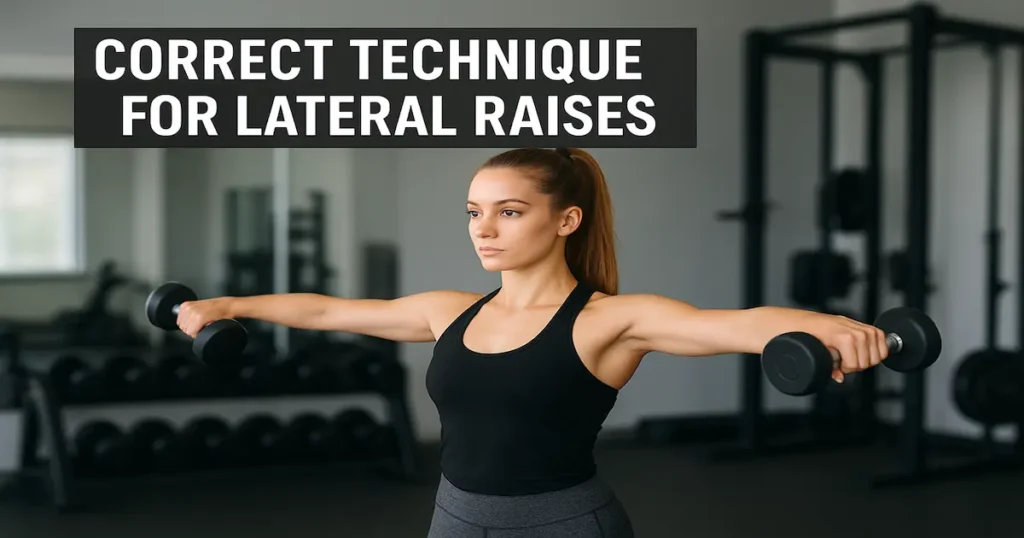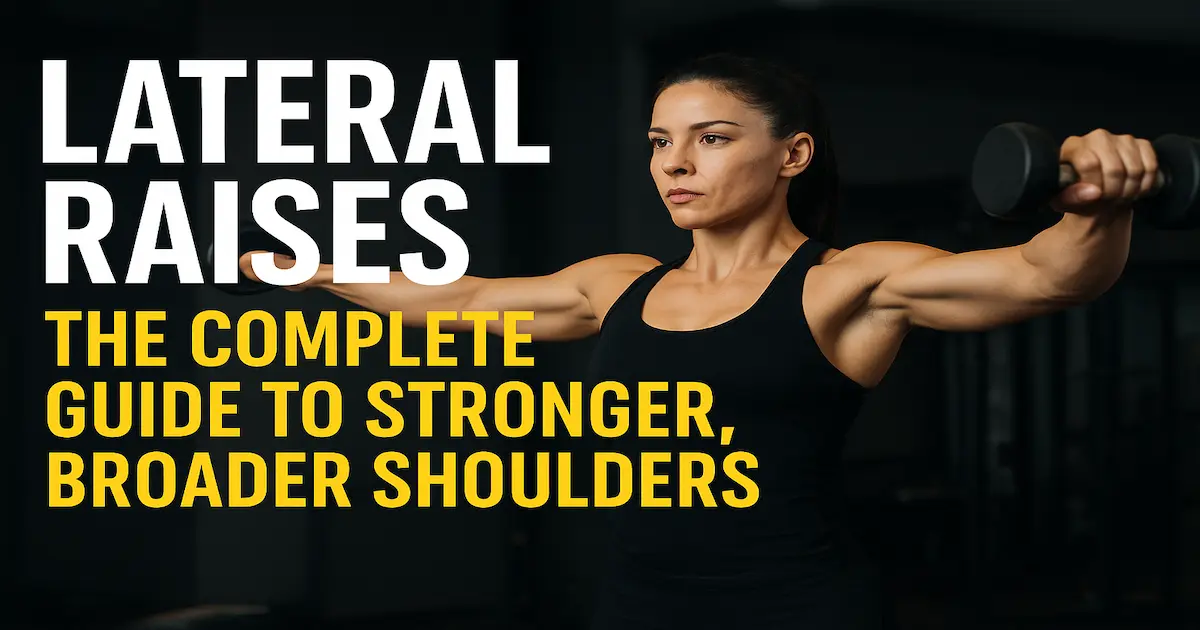The lateral raises exercise is one of the best moves to build shoulder width and create a strong, balanced upper body. It’s a pure shoulder isolation exercise that focuses on the lateral deltoid, one of the three deltoid muscle heads.
This movement has been a favorite for bodybuilders and athletes for decades because it sculpts shoulders without adding stress to other muscle groups.
In gyms everywhere, you’ll see people doing the standing lateral raise, seated lateral raise, and many lateral raise variations.
It’s loved for its simplicity, but its effectiveness comes from proper lateral raise form and control. Done correctly, it can dramatically enhance shoulder stability and give your upper body the v-taper physique many aim for.
Benefits of Lateral Raises
One major benefit is middle deltoid activation. This medial deltoid exercise targets the outer part of your shoulder, making them appear wider and more rounded. This is key for shoulder muscle symmetry and a balanced physique.
Another big plus is functional shoulder strength. Strong shoulders help with everyday tasks like lifting, reaching overhead, or even carrying groceries.
Lateral raises also help reduce rotator cuff stress by balancing the load across the rotator cuff muscles like the supraspinatus and teres minor. This lowers your risk of shoulder pain or injuries in the long run.
Correct Technique for Lateral Raises

To get results, you must master proper lateral raise form. Stand tall with a dumbbell in each hand. Keep a slight bend in your elbows and lift the weights until they’re at shoulder height. Avoid shrugging your upper traps and focus on using the lateral deltoid to move the weight.
The secret to deltoid hypertrophy here is a controlled tempo. Lower the dumbbells slowly to increase time under tension. Breathe out as you lift, and breathe in as you lower. This method keeps the focus on the shoulder isolation exercise instead of letting momentum take over.
The Lateral-to-Front Raise Combination
This combo mixes the dumbbell lateral raise with a front raise for more deltoid muscle head activation. Start with a lateral raise to shoulder level, then rotate your arms forward for a front raise, and lower slowly. This works the lateral deltoid and anterior deltoid in one sequence.
Read More: Osteoporosis: Strengthening Your Future with Smart Bone Care 2025
You can use this in a shoulder workout routine to add variety and hit more fibers. It’s great for shoulder mobility while adding more stimulus for deltoid hypertrophy. Many athletes use this method in isolation training days for maximum benefit.
Common Mistakes and How to Avoid Them
A big mistake is lifting too heavy. This forces you to use momentum, swinging your arms, and taking work away from the lateral deltoid. Keep the weight light enough for clean form and full control.
Another common error is letting your shoulders roll forward. This can strain your rotator cuff muscles and lead to injury. Always keep your shoulders pulled slightly back to enhance shoulder stability and aid shoulder injury prevention.
Variations to Challenge Your Shoulders
The cable lateral raise offers constant tension, while the resistance band lateral raise works well for home training. You can try the leaning lateral raise for a deeper stretch or the wall press lateral raise for stability and shoulder mobility.
Other unique lateral raise variations include the kneeling lateral raise and the Y raise variation. These target the posterior deltoid as well, which helps with shoulder muscle symmetry and posture correction.
| Variation | Benefit |
|---|---|
| Cable Lateral Raise | Constant tension for all ranges |
| Resistance Band Raise | Portable and joint-friendly |
| Leaning Lateral Raise | Greater stretch and range |
| Y Raise Variation | Targets rear delts and traps |
Warm-Up and Injury Prevention
Before any shoulder strength training, you should do shoulder warm-up drills. Arm circles, band pull-aparts, and light overhead presses prepare your rotator cuff muscles for heavier work. This helps reduce rotator cuff stress and prevent strains.
Also Visit: How to Cure TMJ Permanently: The Complete Healing Blueprint 2025
Also, focus on a safe range of motion. Overextending at the top can stress the supraspinatus. Move in a way that feels smooth and controlled to aid shoulder injury prevention.
Programming Lateral Raises into Your Routine
Most lifters benefit from 3–4 sets of 10–15 reps in a shoulder workout routine. For progressive overload, you can add small weight increases, slow down the lowering phase, or try single-arm training for better focus.
Pair the lateral raises exercise with presses and rows for balanced growth. For example, match them with an overhead press for functional shoulder strength and a face pull for posterior deltoid development.
Conclusion
The lateral raises exercise is more than just an arm lift — it’s a foundation for wide, strong, and stable shoulders. When you focus on proper lateral raise form and consistent practice, you’ll sculpt shoulders, improve function, and avoid common injuries.
With so many lateral raise variations, you can keep your training fresh and keep progressing toward the v-taper physique. Consistency and control are your best tools for deltoid hypertrophy and lasting shoulder health.
Frequently Asked Questions:
How heavy should I go for lateral raises?
For the lateral raises exercise, use a weight that lets you maintain proper lateral raise form through all reps without swinging your arms or shrugging your traps. Most people benefit from light to moderate dumbbells, focusing on controlled tempo and time under tension instead of maximum weight.
Are lateral raises good for building shoulder width?
Yes. This is one of the best exercises to build shoulder width because it targets the lateral deltoid, which creates the rounded, broader look. Consistent training improves shoulder muscle symmetry and helps sculpt the upper body for a v-taper physique.
Should I do seated or standing lateral raises?
Both seated lateral raise and standing lateral raise work the lateral deltoid effectively. The seated version reduces momentum and increases isolation, while the standing version allows a more natural range of motion and core engagement. Many lifters use both in their shoulder workout routine.
What are the best lateral raise variations?
Popular options include the dumbbell lateral raise, cable lateral raise, resistance band lateral raise, leaning lateral raise, and Y raise variation. Each variation changes muscle tension, range of motion, or stability demands, helping boost deltoid hypertrophy and preventing plateaus.
Can lateral raises cause shoulder injury?
When done with proper lateral raise form, they are safe and even help reduce rotator cuff stress by strengthening supporting muscles like the supraspinatus and teres minor. Avoid heavy weights, poor posture, or jerking motions to aid shoulder injury prevention.
How often should I do lateral raises?
Most people see results with 2–3 sessions per week, including them in a balanced shoulder strength training plan. You can use them on push days, upper-body days, or in isolation workouts for functional shoulder strength.












